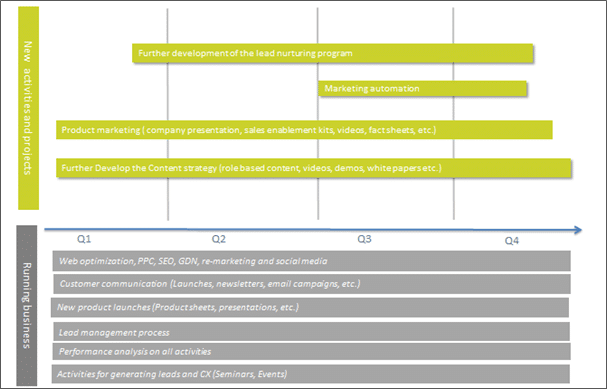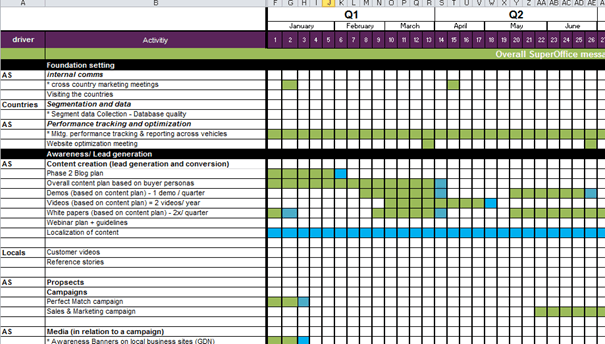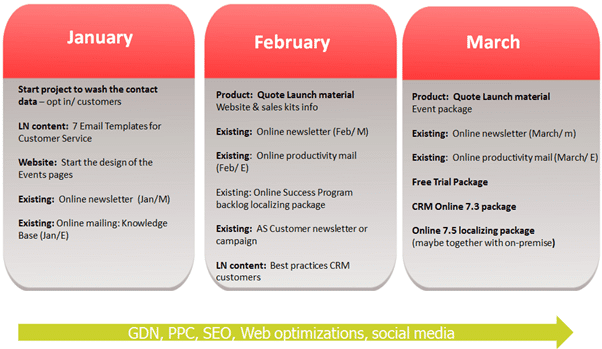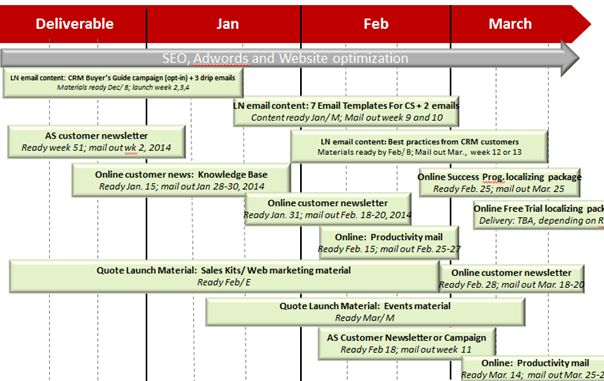
Europe has the greatest linguistic and cultural diversity of the Western world. Unlike the U.S., Europe cannot be treated as one market. In 2007, I was responsible for centralizing SuperOffice marketing, creating economies of scale and driving a common marketing strategy across SuperOffice’s 7 main European markets.
The Challenge
The company was founded in 1990, and each country had its own marketing department budget that he/ she controlled – Campaigns were created separately, no best practices were shared, and there was no common way of measuring the success.
As marketers, we want our customers to recognize the brand regardless of the country they’re in. Brand recognition is built over time and it encompasses not only how things look, but how things are communicated and also how customers perceive the brand.
For SuperOffice, the brand experience and the “red thread” in the communication was not consistent across all the markets. When you’re trying to build brand recognition, the lack of coherence can be a detriment to future growth.
So, how do you work with 7 subsidiaries, all in different countries, in order to execute a common marketing strategy and plan?
It all comes down to project management, communication and collaboration.
“He who fails to plan, plans to fail.”
If communication and expectations are not clear, in addition to a different type of working culture, there was a lot of miscommunication between the countries. While the global marketing activities were delivered for the local countries to implement, they were also implementing their own marketing plans.
What we found quickly was that these activities weren’t communicated ahead of time, and it was difficult for the local countries to execute within the time frame. There was a lot of back and forth, negotiating and well, let’s just say it was a bit of chaos. What the company needed was a marketing plan with a solid operational model.
The Operational Model Uncovered
An operational model describes how you and your team will work, communicate and cooperate together. Specifically, an operational model helps to understand ownership, time frame and deadlines.
For the SuperOffice Marketing Group, our operational model consists of 5 parts:
1. Planning of the overall marketing plan for the year
In October, I update the marketing strategy to meet corporate goals and I create a marketing activity plan. In this plan, I communicate what has worked well this year, what needs improvement and what I think that we should focus on for the next year. This plan is based on marketing performance results, trends we see in the market, as well as the goals that we want to achieve.

Once I have finished the plan, I present it to the Executive Management team for approval. When they have approved the goals and the plan, then I create an overall activity plan which estimates when we will do what activities. This main overall plan is then used as the foundation for all other planning such as budgeting and the quarterly planning and communication. It looks like the following:

This plan is then communicated to the local countries by the end of November and covers an annual review, focus for the upcoming year and KPIs.
2. Quarterly Executive Management meetings
At the beginning of the year, I schedule out all of the quarterly executive management meetings with the Chairman of the Board and the CEO of the company for the whole year.
In this meeting, I review the quarter’s performance results, bring up any issues that I think we need to discuss or draw their attention to and then I present the next quarter’s plans for approval. Getting management buy-in is the key to moving forward with the local countries.
The reason I break up the annual plan into a quarterly plan is that it is difficult to manage a whole elephant. It has to be broken up into pieces. This helps you, management and your team to stay focused on the top priorities. The meeting with the management happens in the first month of the new quarter.
3. Planning for the Upcoming Quarter
Marketing is centralized at SuperOffice. This means that the global team is the main creator and driver of all marketing activities and the subsidiaries execute those activities. In order for this to happen, we have to be very good at not just planning, but also communicating what is coming up.
In the second month of every current quarter, I deliver the quarterly plan for the upcoming quarter to the subsidiaries. This is also the same quarterly plan which was previously approved in the Quarterly Executive Management meeting. This is called the Quarterly Deliverables plan and it tells the countries what the global team will deliver in each month. This quarterly plan is uploaded into the project management tool.

After a couple of weeks, I then create a deliverables timeline which I upload into the SuperOffice project (to-do list). This to-do list tells the countries on WHAT DATE we will deliver something and WHEN I expect that they will execute the activity. In this way, they know what is coming and they are also able to plan localizations, as well as to be able to create their own local plans.

4. Monthly 1×1 meetings
Everyone is busy being busy. I get it. But sometimes, nothing beats a face-to-face meeting.
At the beginning of the year, I schedule monthly 1×1 meetings with every marketing responsible in the local markets for the 3rd Thursday of every month. These meetings always happen via video teleconference where we can have a chance to meet almost “in person”.
In an hourly meeting, the local marketing responsible and I have a chance to discuss how things are going in their local market, what challenges he/ she is experiencing when executing the marketing plan, as well as a chance for them to hear some of the plans that central marketing is working on and what is up and coming.
5. Friday emails
Now we are getting down to the details, but the devil is in the details, right?
I started the Friday email because I wanted to keep the local marketing responsible apprised of what the central team was doing, what was coming up and also remind them of activity dates.
It turned out that the local marketing team loved the Friday emails. The Friday email is created and uploaded to our intranet site every other Friday. It is a combination of status of activities, notes of what coming up and reminders of dates and what needs to be done.
The Outcome
Since the change, SuperOffice has been able to generate more leads and revenue for the company. But, the most important thing was that we became one team executing one strategy, and have:
- Re-launched a new corporate identity
- Established a common lead management strategy
- Established a common performance tracking method
- Implemented a common lead generation strategy
- Implemented a common media strategy
- Implemented a common content marketing plan
Lessons Learned
This central way of working took one year to put into place and another year to fine-tune the model. It took a lot of focus, hard work and dedication to pull it all together. Here are three lessons I learned during this process.
1. Never underestimate the power of communication
Don’t think that one form of communication, whether email, Powerpoint, or meeting is going to cut it. You’ll probably have to say something 5+ times in 5 different ways before something will stick. Just be patient. Grin and bear it. You’ll be much happier with the result in the end.
2. Plan long-term, but deliver in the short-term
It’s important for the sake of the company and your team to plan in the long-term – in our case, it’s a year out. In this long-term plan, you’re basically setting the course for where you want to go. But, the grand plan can get overwhelming. The best way to get results is to break up that plan into digestible parts and then start implementing like hell.
3. Make good use of collaboration tools
Sending emails back and forth to different group members is not a good way to manage a team or a project. Everyone in the project needs access to the information whenever they need it rather than scouring through emails in their inbox. We used both a CRM software and a project management software tool to keep control of our marketing communication with internal and external stakeholders. We even used Excel depending upon what type of project it was. Remember, technology is your friend.





